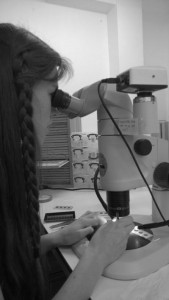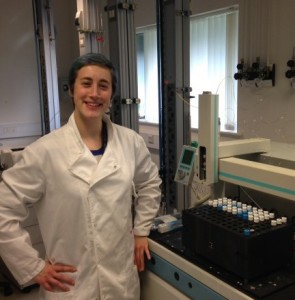Over the summer I completed a four-week Nuffield Research Placement at the Open University in the Environment, Earth and Ecosystems Department. My project was on how optimum growth conditions affect the calcification of planktonic foraminifera.
In other words, I was interested in surface-dwelling plankton. When conditions are 'optimum', these creatures grow in large numbers. But does this increase in numbers affect how surface-dwelling plankton build their shells, and if so, why? Answering this question will give us a better understanding of their ecology and how they will respond in the future to environmental changes.
I studied a species of foraminifera called Globortalia inflata to investigate how the thickness of their shells has changed over the past 20,000 years and then compared my results with published data on the abundance of G inflata (a measure of optimum growth conditions).
The first week of my placement was spent picking out all the specimens of G. inflata from fourteen different samples from the 'Biogeochemical Oceanic Flux Study (BOFS) core 31K'. This is a sediment core collected in the equatorial eastern Atlantic. This sediment core is sliced up into samples every few centimetres, with each sample representing a layer through time.
To begin with I found the selection of specimens really difficult as all the shells just looked like miniature pieces of popcorn to me. But gradually I developed my own methods and pointers to help me identify my species: a high-arched wide aperture, 3 rounded chambers, etc. It was at this point that I realised how important it is to label your samples clearly; shells all look the same from a distance.
I then spent two and a half weeks weighing and measuring the picked shells. To measure the shells, I had to line up roughly 10 shells at a time on a slide and then take a photo under the microscope. This photo was then analysed using computer software to determine the weight, area and the maximum diameter (known as Feret’s length) of each shell.
Lining up the shells was very tricky at first because, when using a dry paintbrush, they had a tendency to ping all over the place. I learnt that I had to be very gentle and careful to keep them where I wanted. Then each shell had to be weighed individually on a microbalance. I then calculated the area density (a measure of shell thickness) for each shell.
My next task was to analyse the data. I’d never really appreciated before what a time-consuming process data analysis is, but I definitely do now. I had to try and remember my Year 9 ICT skills and create graphs to search for any relationship between area density and optimum growth conditions. Luckily my results did produce some data that I could draw conclusions from, which was a relief.
The fourth and final week of my project was then spent creating my project report and poster. Being the perfectionist I am, I think it was the formatting of the report that took longer than the writing did! It was really interesting to learn how scientific reports are written and I’m sure that this skill will come in handy in the future.
Throughout my project, I learnt a lot of new skills and information about science. It was especially interesting to discover more about geology, a subject that I previously knew nothing about. I also thoroughly enjoyed seeing how the different science subjects all merge in Earth Science. For example I learnt how oxygen isotope analysis is used to determine the climatic temperatures of the past and how the wavelengths of different types of light are used to analyse the mineral composition of Martian rocks.
Overall, my Nuffield Research placement at the OU was a great experience. It was amazing to be able to carry out research where the answers are unknown. I’d like to thank everyone at Nuffield and the OU for giving me this opportunity, especially Pallavi Anand and Kate Salmon for mentoring me throughout my project and also being ready to offer help and advice. I’d also like to thank all the other Nuffield students for making it a fun four weeks and for motivating me through the repetitive bits!


